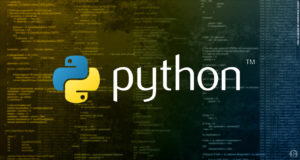Eric Raymond Prefers Python to Perl!
 “There was simply no way I could have pulled off a coup like this in Perl, even with my vastly greater experience level in that language. It was at this point I realized I was probably leaving Perl behind.”
“There was simply no way I could have pulled off a coup like this in Perl, even with my vastly greater experience level in that language. It was at this point I realized I was probably leaving Perl behind.”Link: https://www.python.org/about/success/esr/
D-Link Australia Uses Python to Control Firmware Updates
 “To improve the situation, I decided to develop custom software to handle the upgrades. I started by considering Java for performance but once I looked at the complex Java serial communication code and the language itself I chose Python instead. I was not a programmer and I felt I was not going to be able work with and understand Java code. I believed Python would allow me to focus more on the problem rather than the language.
“To improve the situation, I decided to develop custom software to handle the upgrades. I started by considering Java for performance but once I looked at the complex Java serial communication code and the language itself I chose Python instead. I was not a programmer and I felt I was not going to be able work with and understand Java code. I believed Python would allow me to focus more on the problem rather than the language.
The project was a success. I was the sole creator and developer and was amazed at the results achieved in just over 1,200 lines of code. It took 2-3 months to develop the system, including testing.”
Link: https://www.python.org/about/success/dlink/
Ned Batchelder Prefers Mixing Python in his C++ Code!
 “Although our product is built in C++, we’ve used Python to increase our productivity and expressive power, ease maintenance work, and automate error-prone tasks. Our shipping software is built every day with Python hard at work behind the scenes.”
“Although our product is built in C++, we’ve used Python to increase our productivity and expressive power, ease maintenance work, and automate error-prone tasks. Our shipping software is built every day with Python hard at work behind the scenes.”Link: https://www.python.org/about/success/cog/
Industrial Light & Magic Unifies Their Toolset Using Python!
 “At ILM, speed of development is key, and Python was a faster way to code (and re-code) the programs that controlled the production pipeline.
“At ILM, speed of development is key, and Python was a faster way to code (and re-code) the programs that controlled the production pipeline.
But Python was not designed just as a replacement for shell scripting and, as it turns out, Python enabled much more for ILM than just process control.
Unlike Unix shell scripting, Python can be embedded whole as a scripting language within a larger software system. In this case, Python code can invoke specific functions of that system, even if those functions are written in C or C++. And C and C++ code can easily make calls back into Python code as well.”
Link: https://www.python.org/about/success/ilm/
TTTech Replaces C++ With Python!
 “In our experience, programming productivity is substantially higher with Python than with C++. This is substantiated in detail in a paper presented at OSCON 1999 by one of our developers.
“In our experience, programming productivity is substantially higher with Python than with C++. This is substantiated in detail in a paper presented at OSCON 1999 by one of our developers.
Today, five people are involved with the daily development of our Python-coded tools. Relying on our Python framework, we are able to quickly implement new features, and to adapt the tools to newly available hardware on short notice.
To summarize, with Python we were able to produce a mission-critical set of software products — success of TTP as a communication protocol depends on the availability of high-quality configuration tools — within a short time frame. The code is very easy to maintain, and recoding in Python a whole medium-sized project proved an easy task too. Overall, using Python has led to a successful product line with an ever-growing number of satisfied customers.”
Link: https://www.python.org/about/success/tttech/
Tempest Ditches Perl, Uses Python!
 “It was clear that a unified approach to integration was needed. Python was chosen for it’s flexibility, clarity, and native object-oriented (OO) programming style. Perl was also considered but we felt it would lead to code readability and understandability issues at later times. While easy to write, Perl code often appears very cryptic when read.
“It was clear that a unified approach to integration was needed. Python was chosen for it’s flexibility, clarity, and native object-oriented (OO) programming style. Perl was also considered but we felt it would lead to code readability and understandability issues at later times. While easy to write, Perl code often appears very cryptic when read.
A powerful yet clear multi-platform scripting language was needed to achieve this project’s goal. Python fulfilled this requirement.
With good code reuse — some 40KB of code in the common module, 5-10 KB of initialization code — a lot of programming time was saved. Taking into account that each platform is very different, this was a very pleasant result. The majority of the work that had to be done was analysis and testing, not programming.
The modules described here have been running for almost 2 years now without serious issues. The code is still easy to understand and easy to tailor for a new platform or to add a new feature.
Developing integration code with Python is fast and easy. Python’s native OO approach — something that was not available in our older integration languages — made it easy to create reusable code with minimal effort. This project has shown the great power of Python and open source tools in general.”
Link: https://www.python.org/about/success/tempest/
VAHNZ Controls Prefers Python
 “I feel that the selection of the Python programming language is a move in the right direction. Technology is always evolving and no one knows what comes next, but I am confident that Python will be there ready for the challenge. Platform independence is another aspect to feel good about — betting all the chips on one player might be riskier than ever in today’s climate.”
“I feel that the selection of the Python programming language is a move in the right direction. Technology is always evolving and no one knows what comes next, but I am confident that Python will be there ready for the challenge. Platform independence is another aspect to feel good about — betting all the chips on one player might be riskier than ever in today’s climate.”Link: https://www.python.org/about/success/guards/
Journyx Relies on Python
 “In developing Journyx, the two greatest benefits of Python were the speed with which features could be written and deployed, and its true write-once-run-anywhere cross-platform capabilities.
“In developing Journyx, the two greatest benefits of Python were the speed with which features could be written and deployed, and its true write-once-run-anywhere cross-platform capabilities.
Journyx developers have found that the simplicity and clarity of Python combine with its object-oriented properties to make it a very powerful and productive language. Python’s rich standard library, which includes modules for things like string manipulation and HTML generation, further supports programmers in meeting aggressive development schedules.
Python has been an important competitive advantage for us, and even as our Python code base grows in complexity and maturity, the natural advantages of Python enable us to provide a high quality mission critical application at a competitively low cost.”
Link: https://www.python.org/about/success/journyx/
D-Level Coded 98% of Their Devil Framework in Python!
 Python is our “secret weapon”. It gives us order-of-magnitude increases in productivity thanks to:
Python is our “secret weapon”. It gives us order-of-magnitude increases in productivity thanks to:
- Simple syntax and clear coding style: it effortlessly forced us to use a consistent and expressive coding style. Now it’s easy to look at a piece of code and understand at a glance how it works (nearly impossible with the first Perl version).
- Rapid development cycle: Python removed the tedious and long code/build/run/crash development cycle.
- It allowed us to development one of the hottest features of our system: when we upgrade or install some new code into the system, it dynamically updates itself, either the client and the server. Imagine this: with a simple double-click you install a plugin on the central server, update it (propagating the changes to all the nodes of the system that are using it), run it, download its client stuff into the console and make it active (dynamically updating the GUI). Everything without restarting nor the server nor the client.
- Extensive and complete standard library and great external modules.
- And when there’s no standard library or external module, it’s really easy to build wrappers around a third-party library (especially with the ctypes module)
- Easy and fast code refactoring: we have some old code that gets updated all the time.
Link: https://www.python.org/about/success/devil/
ForecastWatch.com Feels Python Made it Possible
 “ForecastWatch.com is a 100% pure Python solution. Python is used in all its components, from the back-end to the front-end, including also the more performance-critical portions of the system.
“ForecastWatch.com is a 100% pure Python solution. Python is used in all its components, from the back-end to the front-end, including also the more performance-critical portions of the system.
Python was chosen initially because it comes with many standard libraries useful in collecting, parsing, and storing data from the web.”
Link: https://www.python.org/about/success/forecastwatch/
AstraZeneca Uses Python for Collaborative Drug Discovery
 “In 2000, AstraZeneca wanted to improve [their] process so that experimental chemists could make better computational predictions on their own, and so that the research of the computational chemists could progress at a faster rate, and make its way into the lab more quickly.
“In 2000, AstraZeneca wanted to improve [their] process so that experimental chemists could make better computational predictions on their own, and so that the research of the computational chemists could progress at a faster rate, and make its way into the lab more quickly.
Pierre Bruneau, a Principal Scientist at AstraZeneca, had worked on this problem while at Zeneca, which merged to form AstraZeneca. He developed a web-based interface called H2X, named after the allied navigation systems used during the second world war. H2X was based on an in-house molecular property calculator called Drone. This system used a Perl script which computed some of the simpler molecular properties by calling the appropriate prediction program, usually through a wrapper written in Perl, csh, or a domain specific control language.
H2X using Drone was a successful experiment and it was used by many people. In 2001 AstraZeneca decided to develop it further and brought in Andrew Dalke as a consultant, to improve the back-end code by making it more robust, extensible, and maintainable. Andrew, a well-known advocate for Python in computational chemistry and biology, convinced the group that Python was the appropriate language for the next generation back-end, which was named PyDrone.
Python was chosen for this work because it is one of the best languages available for physical scientists, that is, for people who do not have a computer science background. Many other powerful and expressive high level languages exist, including Perl, Lisp, Scheme, Ruby, CAML, and Haskell. Of all these, Python is one of the few that is based on research into usability and the factors that make a programming language easy to learn and use. Yet Python was also designed to solve real-world problems faced by an expert programmer. The result is a language that scales well from small scripts written by a chemist to large packages written by a software developer.”
Link: https://www.python.org/about/success/astra/
 Nagesh Rao conducts seminars in various places to educate people on how Python is the best choice for programming! He admires the simplicity and omnipotence of C, the support for OOP in C++, the ease of coding in and maintainability of Java, and the brevity of Perl! He adds that what makes Python a very appropriate language for him is that Python can be extended using C/C++, can run within the JVM and communicate with Java, and provides the brevity of Perl without it’s obscurity! As a big fan of Object Oriented Programming paradigm, he loves the fact that Python is completely Object-Oriented! He also conducts workshops and training programs on Python for students and working professionals. Enquiries may be sent to [email protected].
Nagesh Rao conducts seminars in various places to educate people on how Python is the best choice for programming! He admires the simplicity and omnipotence of C, the support for OOP in C++, the ease of coding in and maintainability of Java, and the brevity of Perl! He adds that what makes Python a very appropriate language for him is that Python can be extended using C/C++, can run within the JVM and communicate with Java, and provides the brevity of Perl without it’s obscurity! As a big fan of Object Oriented Programming paradigm, he loves the fact that Python is completely Object-Oriented! He also conducts workshops and training programs on Python for students and working professionals. Enquiries may be sent to [email protected].

Related Articles
No user responded in this post